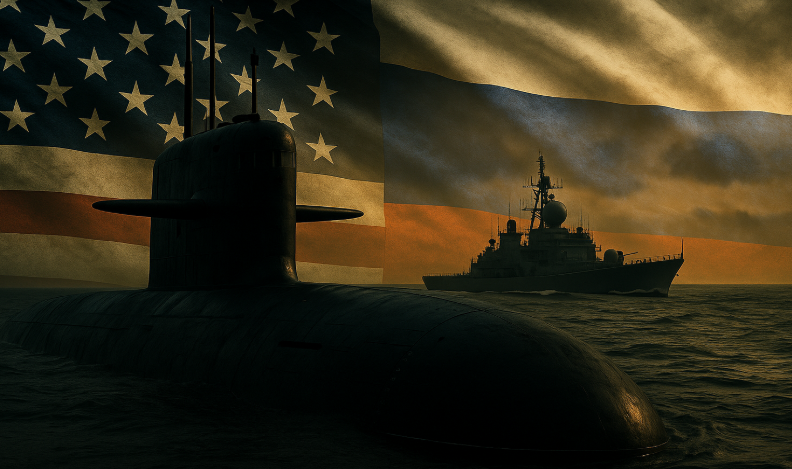In a dramatic turn of events, the United States has deployed two nuclear submarines in response to growing threats from former Russian President Dmitry Medvedev — a move that has reignited fears of a new Cold War. But this isn’t the first time the world has come terrifyingly close to nuclear disaster. Sixty years ago, during the Cuban Missile Crisis, the U.S. and the Soviet Union were just moments away from launching nuclear weapons. One wrong decision could have triggered a global catastrophe and wiped out humanity as we know it.
As President trump Deploys Nuclear Submarines,The World Remembers the Day It Held Its Breath
In a shocking new escalation of global tensions, the current U.S. President has ordered the deployment of two nuclear submarines amid a sharp warning from former Russian President Dmitry Medvedev. This alarming development has sparked global anxiety about the possibility of a new Cold War — or worse, a nuclear confrontation.
But history has already brought us terrifyingly close to this edge once before. And what happened back then was arguably even more dangerous than what we are witnessing today.
Let’s go back to the year 1962 — to what is now known as the Cuban Missile Crisis, a 12-day standoff between two nuclear superpowers: the United States and the Soviet Union.
The world had just come out of the horrors of World War II. The nuclear bombings of Hiroshima and Nagasaki had revealed the devastating power of atomic weapons. The U.S. was the first to wield this power, but by the late 1940s, the Soviet Union had also successfully developed nuclear weapons, entering the deadly arms race.
During the Cold War, both nations kept thousands of nuclear warheads ready for launch by land, air, and sea. Nuclear submarines lurked quietly in international waters, bomber aircrafts circled 24/7 in the skies, and missiles were stationed just miles away from enemy borders.
The U.S., for example, had installed nuclear missiles in Turkey and Italy — both NATO allies — putting them within easy range of the Soviet Union’s western regions. In response, the Soviet Union sought to station its own missiles close to U.S. soil. The ideal location? Cuba.
Cuba, just 200 kilometers southeast of Florida, had recently embraced communism under Fidel Castro. The U.S. had long seen Castro’s regime as a threat and had already tried to overthrow it with the failed Bay of Pigs invasion. The Soviets saw an opportunity to support Cuba militarily while also creating a strategic nuclear outpost.
In a secret deal between Soviet Premier Nikita Khrushchev and Fidel Castro, the Soviets began installing medium and intermediate-range ballistic missiles (MRBMs and IRBMs) on Cuban soil — in complete secrecy.
The U.S. got wind of these operations through intelligence reports, but there was no proof — until an American U-2 spy plane captured high-resolution images confirming Soviet missile installations in Cuba. The revelations sent shockwaves through the White House.
President John F. Kennedy and his administration were faced with a dilemma: attack the missile sites and risk triggering World War III, or find a diplomatic way out.
Meanwhile, the world was completely unaware that the U.S. Navy was in a tense underwater standoff with a Soviet B-59 nuclear submarine in the Caribbean Sea.
The B-59 had lost contact with Moscow while hiding deep in the ocean. U.S. naval forces began dropping signal depth charges (non-lethal bombs used to signal submarines to surface) near its location. Unaware that these were non-lethal warning charges, and cut off from communication with headquarters, the B-59’s crew believed a war had already begun.
The submarine was armed with a nuclear torpedo. Under Soviet protocol, all three senior officers aboard needed to agree before launching a nuclear weapon. Two of them agreed to fire.
But one man — Vasili Arkhipov — stood firm against the decision.

Executive Officer Arkhipov argued that launching a nuclear torpedo without confirmation of war would be catastrophic. He insisted on surfacing the submarine and reestablishing contact with Moscow first. After intense debate, his decision prevailed. The submarine surfaced and received orders to return to the Soviet Union.
Historians now credit Vasili Arkhipov with single-handedly preventing a nuclear war that could have wiped out over 70% of the world’s population. His restraint gave both nations time to de-escalate.
Following tense negotiations, the U.S. agreed not to invade Cuba and secretly promised to remove its missiles from Turkey and Italy. The Soviets, in turn, withdrew their missiles from Cuba.
This 12-day crisis is now remembered as the most dangerous moment in human history — the closest the world has ever come to full-scale nuclear war.
As the current U.S. administration moves its nuclear submarines into position in response to Russian threats, it’s a grim reminder that we’ve been here before — and barely made it out alive.
With nuclear powers once again engaging in verbal warfare and military signaling, it is crucial for world leaders to remember the lessons of 1962. In moments like these, restraint, diplomacy, and the wisdom of even one person — like Arkhipov — can mean the difference between survival and annihilation.
Let history not repeat itself. Because the next time, we may not be so lucky.

